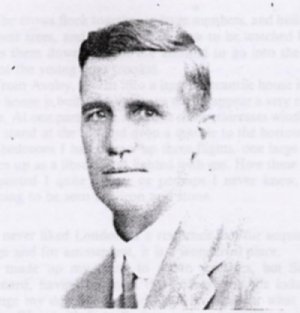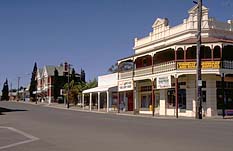

John Sewell 1785 - 1873
Pioneer of Western Australia
By Glennis Sewell
This article was originally published in the April 2001 edition of Soul Search, the journal of The Sole Society.
Born in Little Maplestead, Essex on the 4th December 1785, the eldest son and second child of John SEWELL (1756-1843) and Elizabeth SMOOTHY of Maplestead Hall, John SEWELL and his family migrated to Western Australia – then known as the Swan Colony - in 1841. He was preceded by two of his sons, John (1813-1901) and George (1817-1891), who had made the long and arduous trip from England several years earlier.
John Sewell Senior spent his early years in Little Maplestead, Essex where his father was tenant of Maplestead Hall and well known for his interest in the production of seed crops and his involvement with the invention of the mole plough. John was the second of thirteen children, all born at Little Maplestead, and the only one to travel abroad. He married Ann ALLEN, daughter of William and Ann ALLEN, in Rochford Essex on the 15th October 1811, probably meeting her after he went to live as a tenant farmer at nearby Hadleigh Hall. They remained at Hadleigh Hall for about four years and at least the first two children, Edgar and John, were born at Hadleigh Hall in 1812 and 1813. No record of their births has been found on parish registers, though both births are recorded in Dr William’s Library index.
From Hadleigh Hall the family returned to Little Maplestead for about a further twelve years, during which time a further eight children were born. Apart from his youngest child Martha, all of his children were christened at Castle Hedingham Independent Chapel, the first five in one ‘batch” on the 3rd January 1820 and the rest of the family as they came along. In around 1828 John and Ann moved their family to South Ockenden, John being a tenant of Sir Thomas Lennard on the Aveley Estate. During this period, in 1831, their youngest child Martha Ann (1831-1911) arrived and was christened at the South Ockenden Independent Chapel.

W.O. Sewell, Grandson of John Sewell
John Sewell Junior left Aveley and spent some time in London working in a Mercantile House. He had decided to go to America, where his older brother Edgar had migrated, but his mind was changed by Sir Thomas Lennard who had a son in the Swan Colony and so, in 1834 at the age of twenty, John undertook his adventure on board the barque “Adams”, a vessel of 300 tons, sailing from Gravesend and arriving at the Swan Colony on the 27th November 1834 after a very slow voyage of nearly six months. He was one of only six passengers on board. He was accompanied on this voyage by Samuel Barker, who was the son of another tenant at Aveley. Shortly after their arrival they undertook the task of sailing to Tasmania for a Mr Henty to accompany a flock of sheep back to the Swan.
Once returned to the Swan River John Sewell leased a block of land from Captain J S Roe, which he and Samuel Barker cropped. After only a year or so he was offered, by Mr Edward Barrett-Lennard, occupation of a grant of land called “St Aubyns” in the district of Beverley. He gave up his original lease and moved to Beverley, about 60 miles east of the Swan settlement. During this time, probably around 1837, John was joined by his brother George.
The Parker family, originally from Lyminge in Kent, were near neighbours. Their daughter Anne Susanna Wyborn Parker, who was born in Lyminge Kent in 1819, caught his eye and they were married at her family property called “Northbourne” in York, Western Australia on the 9th September 1840. Following their wedding they moved to a property in the Dale region called “Waterhatch” which John Sewell ran with his brother-in-law William Mercer Parker.
Their first child John Edward was born on the 31st July 1841. Ten weeks following this event, John’s parents and six siblings arrived in the Colony on the “Mary & Jane”, a vessel of 207 tons sailing from London to Sydney, which arrived at the Swan on the 8th October 1841. The children were Elizabeth, Susannah, Sampson, Sarah, Frederick and Martha. (The remainder of the family were - Edgar who went to America, Henry (1819) whom it is assumed died during his childhood, and Ann who died at the age of eleven in 1826 in Halstead Essex)
The new arrivals settled at Northam on a property called “Egoline” which was near to young John’s own homestead called “Mokine” and over the next thirty-two years of his life John Sewell Senior became a well known figure on the farming scene in the Northam/York districts. He was involved in the Agricultural Society and served as a Justice of the Peace, took an active interest in the development of the districts in which he lived and was responsible for the building of the Church at Katrine near Northam.
His family spread out - son George married Elizabeth Logue, daughter of a well known early settler and they later settled in the Geraldton area of Western Australia, where his descendants still farm to this day. Sampson (1820-1897) married Elizabeth Yule and spent many years managing a northern sheep station at Champion Bay and Frederick (1827-1888) married Charlotte Shepherd, and also stayed with farming.
All of the four sisters married – Elizabeth (1822-1903) to Stephen Stanley Parker and Sarah (1826-1907) to William Mercer Parker, both brothers of John Junior’s wife Anne Susanna Wyborn Parker. Susannah was married (1824-1892) to Henry Newton Wollaston who was a cleric in the Anglican Church and Martha (1831-1911) to James Drummond, a farmer of Toodyay.
John Sewell Senior died in York Western Australia, where he had been living for a number of years, on the 27th April 1873 at the age of 87, his wife Ann having died the year prior on 10th January 1872. They are buried in the old cemetery at York. The headstone still remains intact, although it has been moved to one central place in what is now a park in the town.
John Junior meantime, following a flood in 1847/48, which destroyed his house “Mokine”, had moved back to “St Aubyns” for about three years. In about 1850 with their six children, they moved yet again to a property called “Seaton Ross” which John managed for Mr Alfred Stone, the then Crown Solicitor for the Colony. Here they stayed about nine years. In 1859 John finally branched out on his own, leasing a sheep run at “Noombling” on the Hotham River. Another seven children were born during this period. This was a very isolated area and in 1863 he took up a property leasehold further east in the Mourambine district which afforded better opportunities for the education of his children and had the benefits of being closer to a populated area. The Maplestead homestead was about 8 miles from the settlement at Mourambine and only 32 miles from Beverley. His family by this time had grown to twelve. (One child born in 1858 lived only for one day) The townsite of Pingelly – which was less than two miles from Maplestead, was not proclaimed until 1898 – after the railway was pushed through the valley and Mourambine was overlooked in favour of the new townsite.
Over the next ten years he had many pastoral leases and began to purchase freehold homestead blocks. Three blocks of freehold land, two of which he named “Hadleigh” and “Maplestead” after his Essex homes and the third, which later came to be called “Keywest” remained in the family. His sons George (1855-1916) and Decimus (1857-1938) settled on these and they continue to be farmed by descendents to this day.
The “Noombling” property was taken over by his son Edgar (1849-1937) and is still farmed by his descendants. His other sons, John Edward (1841-1909) farmed another property west of Pingelly, Henry Hawkins (1846-1896) farmed at Beverley before taking over as proprietor of a hotel in the town, and Sampson (1862-1925) ran a hotel in Pingelly. William Exodus died of septicaemia at the age of 20 after a falling from a horse onto a stake.

Pingelly Main Street today
John Junior died in 1901 at the age of 87 years and is buried in the Pingelly Cemetery, where a headstone marks his gravesite. Like his father before him, John had been prominent in district affairs including the Road Board, Education board and church activities. He was also a Justice of the Peace and had taken a great interest in the politics of the developing colony.
His wife Anne died in 1916 at the great age of 97 years. She had reportedly been blind for the last forty years of her life and had been cared for by her extended family at “Hadleigh”.
Descendants from all members of this pioneering family are now scattered around Western Australia, many of them still engaged in the farming industry
Glennis Sewell is a great great grandchild of John Sewell (1785-1873) and granddaughter of Decimus (1857-1938). She was born at Pingelly and grew up on the property called “Keywest” before moving to Albany in Western
Return to The Sole Society Home Page